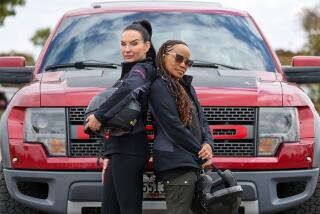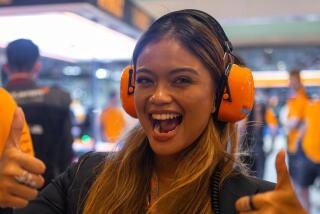Beyond Thinking Pink : Cars have long reflected men’s needs. But now designers have women in mind.
- Share via
What would a car look like if it had been designed by a woman? Seat belts would not wrinkle clothes or smash breasts.
Shoe heels wouldn’t be worn out by pedal-pushing.
And there definitely would be a place to put a purse.
Today’s cars reflect their makers: men. For the most part, they are designed by men, for men. They have been customized for men’s comfort, men’s fascination with technology, men’s need to speed.
“In the past, any car for a woman came in the form of tokenism,” says Joseph Molina, spokesman for the Greater Los Angeles Motor Car Dealers Assn., referring to the Dodge La Femme and Ms. Mustang of the ‘60s. “But cars were designed primarily with men in mind.”
Slowly but surely, however, women are infiltrating the field of car design--they’re even being pursued by car makers offering scholarships to study automotive design. As a result, future cars might have an entirely new look.
“I approach design from a woman’s point of view,” says Amy Hiroshige, a 31-year-old senior designer at Mitsubishi Motors in Cypress. “It should be easier for women to operate switches with long nails, and easier for women to get out of a car in skirts.”
Although some of these inconveniences might seem trivial, they are not to women. Nor are they to a car industry whose best efforts to accommodate women in the past was to paint a car pink and put in an extra-large make-up mirror.
Chelsea Lau, a transportation design student Art Center College of Design in Pasadena, says she brings a different approach to her designs. To her, car design is comparable to fashion design and gives her an opportunity to incorporate her style and personality.
“I pay attention to different things and have a different attention to detail,” says Lau, 25, who moved to Pasadena three years ago from Hong Kong. “I think about daily life, try to solve problems, try to think of needs as a female; consider grocery shopping, dry-cleaning, how operating a car could be easier for a woman.”
Lau is also working on a design for an open-air car that would maintain a breeze without letting in too much air and causing oddly shaped air-blown hair.
“Men don’t know the problems of females,” Lau says.
(Actually, men have had their own share of problems with cars; it’s only recently that cars have been made user-friendly at all. Previously cars were designed to get people from here to there, never mind comfort.)
According to research, women make up about half of the car-buying public (though luxury cars still are bought mostly by men). And although car companies say they are now taking women into consideration more than ever when designing cars, there are some things, most women would agree, that they just haven’t gotten right.
“The seat belts always wrinkle my clothes,” complains Vicki Karlan, 25, a health educator in Culver City. “I also wish there was more light inside a car. At night I always check to make sure no one is in the car, but there is not a lot of light, and it’s dangerous.”
Says Mary Larkin, a 28-year-old concierge on the Westside: “The headrests come to the wrong place. The seats move forward and backward, not up and down to compensate for the smaller size.”
Mothers with young children have their own wish list.
The back-seat windows of a family car should be tinted, so children don’t get glare in their eyes, says Ramey Johnson, a 36-year-old graphic artist and mother of two. And she wishes the rear-view mirror was designed so that she could see both children. “There are a lot of attachments you can put on (the mirror), but they don’t work,” she says.
“And there should be a bigger trunk. If you have kids, you have a stroller and baby stuff you carry around all the time, and then you go grocery shopping, what do you do with that?” asks Johnson, whose children are 2 1/2 and 4 1/2.
Not only have women’s comfort and convenience historically been ignored, but women have been left out of many safety considerations.
For example, federal regulations require injury testing only on male dummies, which means safety systems in cars are designed to protect healthy young males, says Brian O’Neill, president of the Insurance Institute for Highway Safety, a nonprofit research institute funded by automobile insurers. He said the standard test dummy is referred to as the “50th percentile male.”
As a result, companies design their safety features, including safety belts and air bags, for males rather than for females (although many auto companies do their own independent testing with female dummies).
“If a dummy were a female, there would be differences in dimensions,” O’Neill says. “There is a lack of knowledge (about) injury tolerance in females. All the research on injury has been done on males.”
In both its testing and its designs, the industry is making efforts to cater more to women’s comfort and safety.
Using input from women, the Ford Probe, coming out in July, has focused on women’s needs, says Mark Kelly, small-car design executive for Ford Motor Co. Designers there have developed features with women’s proportions and strength in mind and have geared pedals and buttons toward heels and longer nails.
“Companies want women to have input in their designs, so the ideas that male executives put forward that have pitfalls can be identified,” says Carl Olsen, chairman of transportation for the Center for Creative Studies in Detroit.
Although there is more of a demand for women in the field--and there are more working than there were 20 years ago--there are still few to be found.
At the two U.S. institutions that offer training in automotive design, women’s enrollment remains low. Only five of 52 transportation students at the Center for Creative Studies are women, and Art Center College of Design has eight women among 90 students.
Women also remain in the roles that they’ve traditionally occupied--as color and trim consultants and interior designers. And women in slinky evening gowns are still fixtures at auto shows, pointing and smiling at the latest automobile.
“Society hasn’t encouraged women to go into automotive design,” says Ron Hill, chairman of transportation design at Art Center. “Guys are beating the door down to get into the program, but women are rare.”
One problem women face when entering the field is their lack of experience with cars. When boys were busy bonding with their cars and studying the inner workings of motors, girls were being encouraged to find boyfriends with cars.
Lau, who only recently learned how to drive, began at Art Center as a product designer and switched to car design after taking an automotive drawing course. She soon found that she had to learn what her colleagues had known since boyhood.
In addition to playing catch-up with the men in her program, Lau has had to deal with some stereotyping.
Lau’s latest car model, for example, is painted a shimmery forest green--a color Lau overheard colleagues describe as feminine.
“If a guy designed it, they’d call it wild, or unique,” she says. “But because it’s me, it’s feminine. I can design as macho as a guy.”
Car companies already are starting to take women drivers into account, recognizing what ex-bionic Ford-pusher Lindsay Wagner says is true: “Cars are a lot like men. Some you want to date, some you want to marry.”
In an effort to make cars marriage material, manufacturers are trying to improve a car’s attractiveness along with passengers’ comfort.
Truman Pollard, chief designer at Mazda Research and Development of North America Inc., says the industry is working on adjustable seat belts that would fit more comfortably as well as on making controls easier to use.
“Things have to work for women and men,” Pollard says. “Not everyone will be happy, but we try to have room for everything.” Pollard says designing for specific women’s needs isn’t as straightforward as it sounds. “If we make controls for women’s nails, how long are the nails? And if we want to design a space for a purse, we need to figure an average size.”
Mary Larkin and her friends certainly are waiting for a solution to their longstanding problem.
“When there is a car full of women, we have to put all our purses on our feet,” she says. “It makes for a very claustrophobic ride.”






